 |
Site created 12/15/97.

page created: 12/12/06
 Back to Page One |
| Classic
Reviews Round-Up #33 and New Announcements (Continued) Being late November (at time of writing, anyway), it's time for Warners' annual dip into the Looney Tunes well. The Looney Tunes Golden Collection: Volume Four is the latest one and it offers another 60 cartoons spread over four discs. (A two-disc Spotlight Collection that includes 28 of the cartoons is also available.) 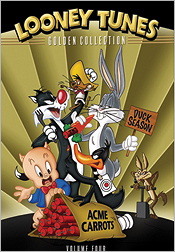 According to the packaging, all are restored, remastered, and uncut. A caution addressing some of the racist and politically incorrect content is also included on the packaging, noting that the release is intended for the adult collector and may not be suitable for children. As usual, Bugs Bunny takes pride of place with the first disc devoted to him. It includes 15 cartoons: Roman Legion-Hare, The Grey Hounded Hare, Rabbit Hood, Operation Rabbit, Knight-Mare Hare, Southern Fried Rabbit, Mississippi Hare, Hurdy-Gurdy Hare, Forward March Hare, Sahara Hare, Barbary-Coast Bunny, To Hare Is Human, 8 Ball Bunny, Knighty Knight Bugs, and Rabbit Romeo. Six of them offer audio commentaries and five others have music-only or music-and-effects-only tracks. Disc Two features director Frank Tashlin and thus offers a good dose of very welcome early black and white Porky Pig plus a dash of wartime Daffy Duck. The 15 cartoons included on it are: The Case of the Stuttering Pig, Little Pancho Vanilla, Little Beau Porky, Now That Summer Is Gone, Porky in the North Woods, You're an Education, Porky's Railroad, Plane Daffy, Porky the Fireman, Cracked Ice, Puss N' Booty, I Got Plenty of Mutton, Booby Hatched, Porky's Poultry Plant, and The Stupid Cupid. There are ten commentaries on this disc. Disc Three is given over to Speedy Gonzalez, one of my least favourite of the Warner cartoon.characters (the others are Pepe Le Pew and the Road Runner). The 15 cartoons here (many directed by Friz Freleng) are: Cat-Tails for Two, Tabasco Road, Tortilla Flaps, Mexicali Shmoes, Here Today Gone Tamale, West of the Pesos, Cannery Woe, The Pied Piper of Guadalupe, Mexican Boarders, Chili Weather, A Message to Gracias, Nuts and Volts, Pancho's Hideaway, The Wild Chase, and A-Haunting We Will Go. Four of them have audio commentaries and four have music-only or music-and-effects-only tracks. Disc Four features cats, including of course Sylvester. The cartoons included are the work of several directors including Chuck Jones and Robert McKimson. The fifteen titles are: The Night Watchman, Conrad the Sailor, The Sour Puss, The Aristo-Cat, Dough Ray Me-ow, Pizzicato Pussycat, Kiss Me Cat, Cat Feud, The Unexpected Pest, Go Fly a Kit, Kiddin' the Kitten, A Peck O' Trouble, Mouse and Garden, Porky's Poor Fish, and Swallow the Leader. There are six commentaries and four music-only or music-and-effects-only tracks. In addition each of the discs adds a healthy number of supplements ranging from a lengthy documentary on Bugs Bunny and a profile of director Friz Freleng to various shorts from the vault (including three wartime Private Snafu efforts and Porky's Breakdowns), some behind-the-scenes featurettes, and bridging sequences and audio recording sessions from The Bugs Bunny Show. Warners' fine work on these cartoons is evident. All look and sound in top-notch shape except for some minor imperfections in a couple of the older black and white ones. If you enjoyed the first three volumes, the fourth is equal in quality in terms of the work lavished on it. Only those, like me, who suffer Speedy Gonzalez not gladly will have anything to grumble about. Recommended. 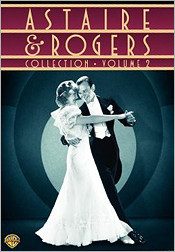   The distinctive, entrancing pleasure of Astaire and Rogers is once again on display in the Astaire & Rogers Collection: Volume 2. The boxed set of five keep cases echoes the format presentation of last year's first volume, but Warners has thoughtfully also made alternative slim case packaging available in two forms. There is an Astaire & Rogers Ultimate Collector's Edition which contains all ten films of the two volumes each in their own slim cases along with an 11th disc containing a new documentary on the duo and several folders of collector's material (pressbooks, poster, stills). For those who have Volume 1, Warners offers (as an Amazon exclusive) a modified version of the Ultimate Edition that omits the Volume 1 discs but does provide empty slim cases to accommodate the five discs from that first volume. The new Astaire & Rogers release contains the five of their films not previously available on DVD - Flying Down to Rio, The Gay Divorcee, Roberta, Carefree, and The Story of Vernon and Irene Castle. The Gay Divorcee and Roberta are the best of the five with Flying Down to Rio also a diverting entertainment at least as long as Astaire & Rogers are on the screen. The Gay Divorcee is an almost perfect blend of comedy (with the likes of Edward Everett Horton, Eric Blore, Erik Rhodes, Alice Brady), romance and music and it offers one of Fred and Ginger's most entrancing numbers - "Night and Day" - as well as one of the more bizarre yet memorable non-Fred-and-Ginger ones - "Let's K-nock K-neez" in which Everett Edward Horton is paraded around by a young Betty Grable. Roberta was for many years one of the lesser-seen of Fred and Ginger's films, disappearing into the vault in favour of the 1952 MGM remake Lovely to Look At, but its appearance on laserdisc in the 1990s helped fuel its revival. It contains the wonderful "I'll Be Hard to Handle" dance number as well as a song that's a personal favourite - "Smoke Gets in Your Eyes" (although its performance by Irene Dunne is less than scintillating and Fred and Ginger's wonderful dance to it is frustratingly brief). In Flying Down to Rio, Fred and Ginger together in a film for the first time are really just part of the supporting cast and not really a team as yet. They dance briefly together in "The Carioca" number and perform "Music Makes Me" separately (She sings it at one point while he dances to it at another.) The film is nothing to write home about, but it does light up when Fred and Ginger are on screen either together or separately. Carefree and The Story of Vernon and Irene Castle were the last two Astaire & Rogers films under their RKO contracts and probably the least memorable of their ten films together. (The two would re-team one last time ten years later for MGM's Barkleys of Broadway.) Carefree does offer one lasting number - "Change Partners" and Ginger Rogers seems to have more of the film than does Astaire, perhaps reflecting the fact that RKO was at the time building up Rogers as a romantic-comedy and increasingly dramatic-film star. The Story of Vernon and Irene Castle was a departure for Astaire & Rogers in that it was basically a biography of a real couple - the Castles, who had humanized formal ballroom dancing protocols of the 19th century and given a social cachet to the newer dances becoming popular in the pre-World War I years. Many of the dance numbers in the film were proscribed by history leaving little room for individual interpretation, although Astaire certainly seems at home reflecting the fact that he had grown up with them. Fans should be more than happy with Warners' efforts on the DVD presentations. Each of the films looks at least as good and in some instances better than did those in last year's Volume 1. The Story of Vernon and Irene Castle, Roberta, and Carefree are marginally the best-looking, but even Flying Down to Rio is in very good shape. The images are generally very sharp with a nicely-detailed gray scale in evidence. Blacks are deep and contrast is good. There is mild grain present on each film and a few speckles and scratches. The audio has been cleaned up appreciably and only minor hiss is present. Each disc contains vintage shorts and cartoons from the same year of release as the film (including Public Jitterbug No. 1 with Betty Hutton and Beer and Pretzels with Ted Healy and his Stooges), supplemented by theatrical trailers and "Hollywood on the Air" radio promos in a few cases. Highly recommended.  From the sublime to the ridiculous, now it's time for another of my can't-stand Jerry-Lewis's-comedy paragraphs. I knew that watching his unfunny later work without Dean Martin was like having teeth pulled for me, but it had been so long since I saw any of his early films teamed with Martin that I honestly had forgotten my reaction to them and thought I possibly now might find him more palatable in them. Paramount's release of the Dean Martin & Jerry Lewis Collection: Volume One offered an opportunity to find out. After several hours of sampling the eight films in the collection, I can now report that for me Lewis is just as obvious and unfunny with Martin as he was without him. The films are more tolerable overall, but that's only because of Martin's presence and the use of some very pleasing supporting players. At best the films bring a few smiles to the face. The set contains eight features packaged as double features on four single-sided discs nicely packaged in a fold-out digipac (no overlapping discs) contained in a sturdy slipcase. Three of the films have previously been made available on DVD by Paramount: The Stooge, My Friend Irma, and My Friend Irma Goes West. The five new ones, all from 1951-1953, are: That's My Boy, Sailor Beware, Jumping Jacks, Scared Stiff, and The Caddy. Sailor Beware and Jumping Jacks (both service comedies) are usually rated the best of this bunch and I would have to agree. There are numerous sight gags that work pretty well despite Martin's telegraphing of his actions. Martin alternately seems bemused or astonished by his partner's antics and that frequently is what makes the gags effective. Corinne Calvet, Vince Edwards, and Betty Hutton are welcome additions to the cast of Sailor Beware while Don Defore is notable in Jumping Jacks. Scared Stiff is a remake of Bob Hope's The Ghost Breakers and it trots out just about every haunted house cliché in the book. It's territory previously mined by the likes of Abbott and Costello, Laurel and Hardy, and even the East Side Kids - all of whom managed to make it seem much more entertaining. Mind you it is nice to have the company of Lizabeth Scott. That's My Boy (Lewis learns to play football) and The Caddy (Lewis teaches Martin golf) are both weak. Despite their good premises, neither has much inspiration in their actual execution and in fact in That's My Boy, the pair actually seem to be trying to avoid making us laugh. In The Caddy, Martin sings his trademark "That's Amore". Despite my lack of enthusiasm, I imagine Jerry Lewis fans (and Lewis and Martin fans) will be thrilled with this package even given the three duplicated title releases. All the films are presented full frame as originally released and Paramount has done its usual fine job on the transfers. The images are generally sharp and nicely detailed, with only occasional instances of softness apparent. There is a pleasing amount of grain and only a small degree of speckling/debris that never detracts from the viewing experience. The mono sound tracks made been well cleaned up. The only supplement is a trailer for The Stooge. Certainly recommended for Lewis and Martin fans; others should try a rental first. 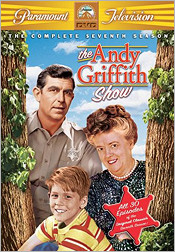 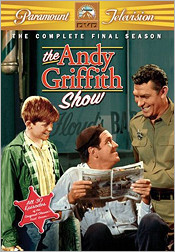 Over the course of the past few months, Paramount has completed its DVD run of The Andy Griffith Show with the release of The Complete Seventh Season and The Complete Final Season. Both sets contain 30 episodes spread over five discs. These last two seasons, as with the sixth season, focus on the continuing Andy (Andy Griffith), Opie (Ron Howard), and Aunt Bee (Frances Bavier) characters, with support from Goober (George Lindsey) and Howard Sprague (Jack Dodson). The latter were two lesser and sometimes annoying characters (especially Goober) that were relied on to fill the void left when Don Knotts (and his character Barney Fife) departed the series as a regular after the 5th season. Fortunately, Knotts returned for a guest visit in one or two episodes each season. The pertinent episodes this time are A Visit to Barney Fife and Barney Comes to Mayberry in season seven and Barney Hosts a Summit Meeting in the final season. But whether Barney was around or not, the series continued to charm viewers with its gentle humour and simple homespun truths. The characters were warm and comfortable and they made their town of Mayberry an appealing place to visit every week. The pleasures of the DVDs allow us to return there any time we want and for that alone, Paramount is commended for persevering with the season releases. The final season ends with the episode Mayberry R.F.D., thus introducing the pallid series spinoff of the same title that lasted three seasons. As with all the previous entries, the DVD packages are basically barebones beyond the episodes themselves. The images are in good shape in terms of sharpness, clarity, and contrast while the mono sound is fully satisfactory. Recommended. 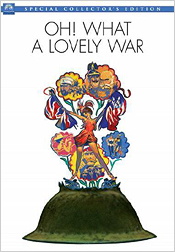 While Paramount has continued its DVD release commitment to TV shows, it has now also begun to show signs of a slightly reinvigorated commitment to its older film catalog titles. The Martin and Lewis films were one example and Oh! What a Lovely War is another. Made in 1969 and based on the stage musical of the same name, the latter was Richard Attenborough's directorial debut. Basically an indictment of the waste of human life that was the Great War, the film juxtaposes the life of the ordinary soldier in the trenches with that of the general military staff responsible for the war's conduct. The latter are portrayed somewhat as referees or coaches treating the whole thing as a sort of game with images of scoreboards showing the loss of life during the latest push at the front like the scores of the most recent rugby or football game. Much of the imagery is surreal (the headquarters of the general staff seems to be located on Brighton Pier along with the other amusements), but it is effective in making the film's point. The famous Christmas ceasefire in which Allied and German troops met on no-man's-land to exchange seasonal greetings is particularly well executed and draws the common soldiers together in their disdain for the whims of both side's upper commands. The music is a mixture of traditional wartime songs and some new numbers. All the latter are quite well staged and are generally melodic if not quite toe-tappers. The film's one failing is its length. It makes its point in the first hour and three-quarters, so that the further half hour that it lasts undoes some of the goodwill previously built up. Look for a who's who of British actors in both major and minor roles: Laurence Olivier, Ralph Richardson, John Mills, John Gielgud, Maggie Smith, Vanessa Redgrave, Ian Holm, Dirk Bogarde, Susannah York, Kenneth More, Jack Hawkins, and Michael Redgrave. The DVD's 2.35:1 anamorphic transfer is excellent, offering very accurate-looking colour, and a richly detailed, sharp image free of any sign of edge effects. The mono sound is adequate although it does little to give the songs the presence they need. Paramount has also stepped up with a very nice package of supplements including an enthusiastic audio commentary by Lord Richard Attenborough that imparts a great deal of information in a listenable though somewhat flat tone of voice. A three-part documentary taking up about 75 minutes complements the commentary nicely. Certainly recommended for those who know of and have a fondness for this film; others should try a rental first. 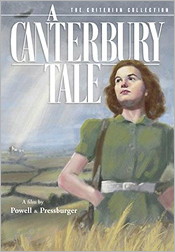 The British filmmaking team of Michael Powell and Emeric Pressburger was responsible for a magnificent run of classic films in the 1940s, many of which have been made available on DVD in typically fine fashion by Criterion. The likes of The Red Shoes, I Know Where I'm Going, Black Narcissus, and The Life and Death of Colonel Blimp are well known, but one of their finest achievements is the somewhat lesser known A Canterbury Tale. Recently released as a two-disc set by Criterion, the film draws inspiration from the pilgrims of Chaucer's "Canterbury Tales" for a story set in the Second World War. Three such modern pilgrims (a young British woman serving in the country's "land army" [Sheila Sim], a plainspoken American soldier [John Sweet], and a British army sergeant [Dennis Price]) are on their way to Canterbury when they are forced to stay over in a British town in the countryside. There they become involved in solving a bizarre mystery before completing their respective voyages, each of which leads to personal growth in a conclusion that can only be described as majestic and immensely satisfying. The film starts rather slowly, but we become entranced by each character's story and the resolutions that lead to Canterbury. Powell and Pressburger use the obvious differences between the relatively undisturbed countryside and the destruction that the war has brought to the city of Canterbury as a powerful counterpoint to the characters' personal progress. Aside from the added authenticity that shooting at locations in Kent and Canterbury provided, their use has also resulted in portions of the film being superb documents of a particular time and place. The film's acting is uniformly excellent, with John Sweet who was not a professional actor being particularly memorable. In addition to the three "pilgrims", Eric Portman also adds an interesting portrait of an enigmatic town magistrate. A Canterbury Tale is a film that creeps up on you, gradually enveloping you in its power as it builds to as conclusion that is revelatory. It's also a wartime propaganda film in disguise that only in retrospect reveals itself as a paean to why Britain was fighting for its very existence at the time. Criterion's presentation is up to its usual standard. The restored high-definition digital transfer provides a nicely detailed image with deep blacks and good contrast. There are speckles and scratches in evidence and a few instances of softness, but they do not detract from the viewing experience. The mono sound is quite adequate although minor hiss is present. The supplements are meaty and include a thorough audio commentary by film historian Ian Christie, a new video interview with Sheila Sim, a documentary about John Sweet based on his return to Canterbury, a new documentary visiting the film locations, a 1942 documentary on the sights and sounds of wartime Britain (Listen to Britain), and a booklet of essays on the film. Highly recommended. 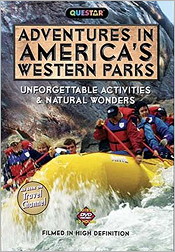 Finally, for something completely different, I have had the opportunity to look at Questar's six-disc box set Adventures in America's Western Parks. Each disc contains almost two hours of material, all shot in high definition although presented here as 1.78:1 anamorphic standard definition DVD. Aside from the general interest in this material for its depiction of many wonders of the natural world in the American and Canadian western areas, fans of western films will find wonderful footage of many locations also immortalized in western films - places such as Monument Valley and Zion, Bryce and Grand Teton National Parks to name but a few. Yellowstone and The Best of the National Parks contains two main programs. The Yellowstone one focuses on the park that has been nicknamed "America's Serengeti" while the other looks at things to see and do in 16 other national parks. Supplements include a National Park Service featurette about the maintenance of Mount Rushmore as well as a couple of photo galleries that are rather redundant if you've already watched the two main programs. Glacier and Zion & Bryce is just that - profiles of those National Parks. It's supplemented by a featurette on avalanches in Glacier as well as two photo galleries. The Great Southwest provides two more programs - National Parks of the Southwest and Secrets of the Southwest. This is my favourite disc in the set because of the profusion of western film locations it covers as well as a focus on the Grand Canyon. Supplements include a fascinating featurette on firefighting in the Grand Canyon, another on Navajo rugs, and a photo gallery. Fire & Ice: Hawaii and Alaska departs the lower 48 and again has two programs - Hawaii's National Parks and Alaska's Denali National Park. There are also two photo galleries. Great Train Rides, Lodges & Inns changes gears somewhat with a focus on some of the travel and accommodation options that the parks have to offer. A featurette on train historical highlights and two photo galleries comprise the supplements. Finally, Canadian Rockies, Vancouver & Beyond offers two programs that take us to Banff and Jasper and to Vancouver, Victoria and Whistler. Photos galleries round out the disc. The video on all the discs is in fine shape, featuring vibrant colour. The images are generally sharp although occasional softness does intrude at times. Anyone interested in National Parks and western films will find much to enjoy in this set, although viewing is best done in small doses. New Announcements As I observed in the last Classic Coming Attractions column, it's apparent that both Warners and Fox are maintaining their classic efforts in 2007, but Universal is also making a nice statement too. Further evidence can be found below. The Classic Coming Attractions Database has been updated as usual and sources for this edition include studio press releases and websites, personal contacts, internet newsgroups, online retailers, and dvd news sites (The Digital Bits, Davis DVD, the Home Theater Forum, DVD Times, TVShowsonDVD, among others). Blue Underground trots out its versions of three spaghetti westerns previously released by Anchor Bay - A Bullet for the General (1967), Keoma (1976), and Texas, Adios (1966) - all due on March 27th. Criterion comes through for classic fans in February with a Powell and Pressburger title, an often-requested British murder mystery, a Mikio Nabuse film, a Paul Robeson box set, and Vittorio De Sica's Bicycle Thieves (1947). The latter, set to appear on February 13th, will be a two-disc set with new interviews/documentaries with De Sica collaborators and a new film on Italian neo-realism. Scheduled for February 20th, the Powell and Pressburger film is 49th Parallel (1941). It will also be a two-disc effort featuring audio commentary by Bruce Eder, a Powell and Pressburger wartime short, and a BBC documentary on Poweel and Pressburger. The often-requested murder mystery is the delightful Green for Danger (1946) starring Alastair Sim in a brilliant turn as a Scotland Yard inspector. The disc includes audio commentary by Bruce Eder and some new interview/essay material. It will be released on February 13th. Paul Robeson: Portraits of the Artist (coming February 13th) will be a four-disc set also including a book containing an excerpt from Robeson's book "Here I Stand" and various new and reprinted essays and articles. Eight films will appear in the set - The Emperor Jones (1933) paired with the documentary short Paul Robeson: Tribute to an Artist (1979); Sanders of the River (1935) with Jericho (1938); Body and Soul (1925) with Borderline (1930); and The Proud Valley (1940) with Native Land (1942). Audio commentaries accompany two of the films and there will be four new video programs featuring film historians, contemporary filmmakers, and Paul Robeson Jr. Finally, the Mikio Nabuse film (set for February 20th) is A Woman Ascends the Stairs (1960) featuring audio commentary and a new interview/essays. In other Criterion news, the company's latest newsletter hints rather strongly that Jules Dassin's The Naked City is in the works for 2007. Critics Choice Video has set December 12th as the release date for the remaining ten Hopalong Cassidy films to appear on DVD. The box set includes the following titles: Renegade Trail, Silver on the Sage, Pride of the West, Bar 20 Justice, In Old Mexico, Santa Fe Marshal, The Frontiersman, Law of the Pampas, Sunset Trail, and Range War. All are from the 1938-1940 period and are made available by arrangement with the authorized rights holder, U.S. Television Office. Mr. Moto fans will be glad to hear that Fox has The Mr. Moto Collection: Volume 2 scheduled for February 13th. It will include the remaining four Peter Lorre films (Mr. Moto in Danger Island, Mr. Moto's Gamble, Mr. Moto's Last Warning, and Mr. Moto Takes a Vacation. As a bonus, Fox has also included the 1965 feature The Return of Mr. Moto starring Henry Silva. Fox has now confirmed the release of The Alice Faye Collection for February 20th. It'll be a four-disc set containing The Gang's All Here, Lillian Russell, On the Avenue, and That Night in Rio. Also on that date comes Voyage to the Bottom of the Sea; Season Two, Volume Two. Moving into March, the anticipated Hemingway Classics Collection will appear on the 6th. It'll include Adventures of a Young Man (1962, with Paul Newman), The Snows of Kilimanjaro (1952, with Gregory Peck), The Sun Also Rises (1957, with Tyrone Power), Under My Skin (1950, with John Garfield), and A Farewell to Arms (1957, with Rock Hudson). Arriving the same day are Cinderella Liberty (1973) and John and Mary (1969). The three Jesse James films previously delayed by Fox (Jesse James, The True Story of Jesse James, and The Return of Frank James) have now been rescheduled for March 6th too. On March 20th another anticipated release arrives - the Michael Shayne Private Detective Collection: Volume 1. Four titles (from 1940-1942, all with Lloyd Nolan) are included on two discs: Michael Shayne, Private Detective; The Man Who Wouldn't Lie; Sleepers West; and Blue, White and Perfect. I'm not sure what Fox's intent would be for a second volume. There are only two other Fox Shayne titles to be released (a third, Dressed to Kill, already appeared on its own last year). Perhaps they could do a deal with the rights holders of the later PRC Shaynes (a company called 'Films of the World"), although Hugh Beaumont is not nearly as effective in the role as Lloyd Nolan. Also due on March 20th is The Shirley Temple Collection: Volume 5 (Stand Up and Cheer [1934], The Little Princess [1939], and The Blue Bird [1940]). It's nice to see Fox rescuing titles such as The Snows of Kilimanjaro and The Little Princess from public domain hell, and it would be nice to have Warners do the same for the likes of Meet John Doe and Santa Fe Trail. Finally, Fox has apparently delayed its release of Blood and Sand from January 9th to April 10th. Grapevine Video has seven more new releases for November. Four of them are from the silent era and include Queen Elizabeth (1912, featuring Sarah Bernhardt; accompanied by two shorts from the same year - Cousins of Sherlock and Jack and the Beanstalk); Smoldering Fires (1925, directed by Clarence Brown); Yankee Doodle in Berlin (1919, featuring many performers from the Mack Sennett studio); and a collection of silent westerns (1920-1927, five two-reelers including Get Your Man, Fight It Out [Hoot Gibson], Battling Travers, The Ore Raiders, and Fightin' Mad [Yakima Canutt]). The three sound releases will be Musicals from 1945 (a double feature of The Big Show-Off [Arthur Lake, Dale Evans] and A Song for Miss Julie [Shirley Ross]); The Great Gabbo (1929, with Erich von Stroheim); and a Hoot Gibson double feature of Sunset Range and Rainbow's End (both 1935). Image's releases for January include a double bill of Majin, Monster of Terror and The Return of Giant Majin (both 1966 but released in North America in dubbed versions two years later) due out on the 9th. Also due on the same date is a four-disc set of episodes of Mister Peepers, a 1953 TV show starring Wally Cox. On January 16th, Image will release That's Black Entertainment, a three-disc set focusing on black independent film of the 1920s, 1930s, and 1940s. Each disc will also be available separately as That's Black Entertainment: Actors (also includes the film Jericho [1937, with Paul Robeson]); That's Black Entertainment: Westerns (also includes the film The Bronze Buckaroo [1939, with Herb Jefferies]); and That's Black Entertainment: Comedy (also includes the film Boarding House Blues [1948, with Moms Mabley]). Image kicks off February with two more Gene Autry films on the 6th: Gold Mine in the Sky (1938) and Public Cowboy No. 1 (1937). Also coming the same day are Hollywood at Your Feet: The Story of the Chinese Theater Footprints (a 1997 91-minute documentary) and re-releases of two previously available documentaries - 20th Century-Fox: The First 50 Years and Cinema Combat: Hollywood Goes to War. Similar to its recent film noir box set, Kino has packaged five of its previously-released titles in a new collection entitled Glamour Girls. Available November 21st, the films included are: The Blue Angel (1930, Marlene Dietrich), Love Me Tonight (1932, Jeanette MacDonald), The Good Fairy (1935, Margaret Sullavan), Lured (1947, Lucille Ball), and Pandora and the Flying Dutchman (1951, Ava Gardner). Lionsgate has announced the Alfred Hitchcock: 3-Disc Collector's Edition for release on February 6th. It will include The Manxman, Rich and Strange, The Skin Game, Murder!, and The Ring - all from 1927-1931. There are no further details available as yet. MGM has a two-disc Fiddler on the Roof: Collector's Edition set for January 23rd. There are no other details available at this time. MPI has now set February 27th as the release date for The Doris Day Show: Season Four. Paramount's connection with CBS Video bears more fruit on March 6th with the release of Hawaii Five-O: Season One. It'll be a 7-disc set containing 23 episodes plus Coccoon - the feature length TV movie that kicked off the series. The previously anticipated Lucy-Desi Comedy Hour is set for release on March 13th. It'll be a four-disc set with over 12 hours of material and is being referred to as I Love Lucy: The Complete 7th, 8th and 9th Seasons. Then on the 20th, expect The Wild, Wild West: Season Two with all 28 episodes on seven discs.. The website tvshowsondvd.com reports the possibility that the oft-requested TV series The Untouchables and The Fugitive will both begin to appear on DVD in 2007, courtesy of Paramount/CBS, beginning with a release of the first half of their respective Season Ones. Both will be most welcome. Sony has two rock music double bills set for January 23rd - Don't Knock the Rock/Rock Around the Clock and Don't Knock the Twist/Twist Around the Clock. All four will be in anamorphic widescreen. On February 6th, Here Comes Mr. Jordan (1941, with Robert Montgomery and Claude Rains) finally makes its DVD appearance. Then on February 13th, Sony does a double dip on Gandhi, the 1982 Oscar winner that doesn't really fit the classic mandate of this column, but does have the feel of classic filmmaking to it. Designated a 25th Anniversary Edition, it'll be a two-disc set with a 2.35:1 anamorphic transfer and Dolby Digital 5.1 track. Supplements will include an introduction to the film and an audio commentary with director Richard Attenborough, and a whole raft of featurettes, only a few of which are carry-overs from the previous DVD release. On February 20th, we'll get A Man for All Seasons: Special Edition (no details available as yet) and another of those useless Three Stooges B&W/Colourized combinations - Hapless Halfwits (contains Beer Barrel Polecats, I'll Never Heil Again, Brideless Grooms, and Dopey Dicks). Universal has joined the classic fray more fully with a new line called Universal Cinema Classics. It will debut on February 6th with a first wave comprising All Quiet on the Western Front (1930), Arabian Nights (1942), Going My Way (1944), and The Heiress (1949). Each will include an introduction and the theatrical trailer, and if recent Universal experience is any indicator (e.g., Holiday Inn), sparkling new transfers. There's no indication so far as to how often subsequent waves will appear. On March 20th, look for the W.C. Fields Comedy Collection: Volume Two. It will include five films each presented on its own disc: You're Telling Me (1934), The Old-Fashioned Way (1934), The Man on the Flying Trapeze (1935), Poppy (1936), and Never Give a Sucker an Even Break (1941). Each title will also include its theatrical trailer. There is word that VCI will have a new version of the 1951 Scrooge out on DVD for Christmas, but for 2007, not this year. The source material will be a new 35mm fine grain print. Meanwhile, VCI has delayed the release of several of its November 28th titles. The two Red Ryder double bills and the George Reeves double feature will now appear on December 12th and the next two volumes of the Hammer Film Noir series will appear on December 26th. Coming on December 19th are two serials - The Lost City (1935, with William "Stage" Boyd and Kane Richmond) and Lost City of the Jungle (1946, with Lionel Atwill). Warner Bros. has announced a Literary Masterpieces Collection for release on March 6th. Included are six films on five discs: Billy Budd (1962), Captain Horatio Hornblower (1951), Madame Bovary (1949), The Prisoner of Zenda (1937 and 1952 double feature), and The Three Musketeers (1948). Each disc will also be available separately. On March 27th, Warners will finally satisfy many Errol Flynn fans with Errol Flynn: The Signature Collection Volume Two. It will contain five features (each also available separately) - Adventures of Don Juan, Charge of the Light Brigade, The Dawn Patrol, Gentlemen Jim, and Dive Bomber. Most of them will be accompanied by a "Warner Night at the Movies" suite of supplements while one (Don Juan) will have audio commentary by director Vincent Sherman and historian Rudy Behlmer. This is great news, but I hope it doesn't mean we've got to wait another two years to get Edge of Darkness on DVD! In High Definition news, Universal has scheduled an HD-DVD version of The Sting (1973) for January 16th. At last word, it will include the supplements from last year's Legacy release. Otherwise the High Definition world is devoid of classic releases early in the new year. Well, once again that's it for now. I will return very soon with one last 2006 Classic Coming Attractions column complete with a few Christmas-themed reviews. See you then. Barrie Maxwell barriemaxwell@thedigitalbits.com |
Barrie Maxwell - Main Page
 |
| Site
designed for 1024 x 768 resolution, using 16M colors and .gif 89a
animation. © 1997-2015 The Digital Bits, Inc., All Rights Reserved. billhunt@thedigitalbits.com |